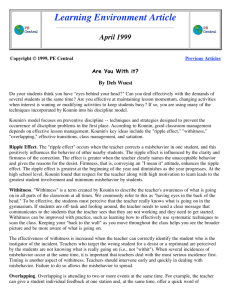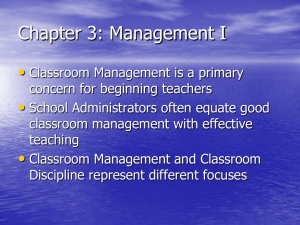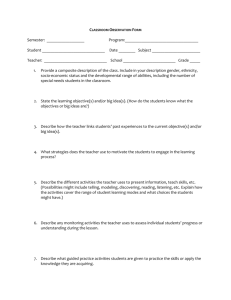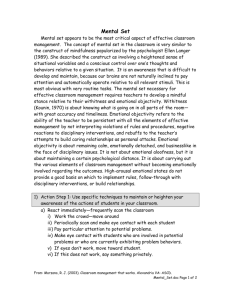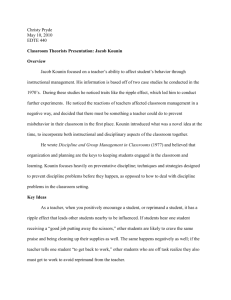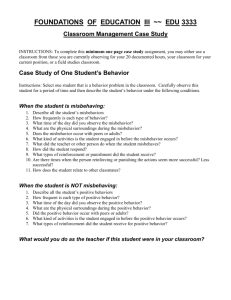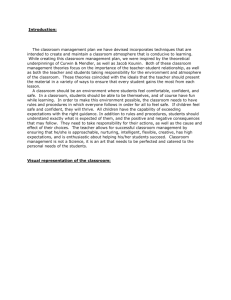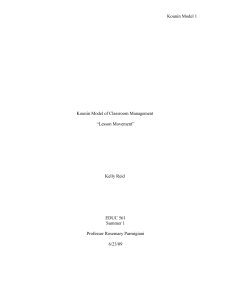Kounin-engl
advertisement
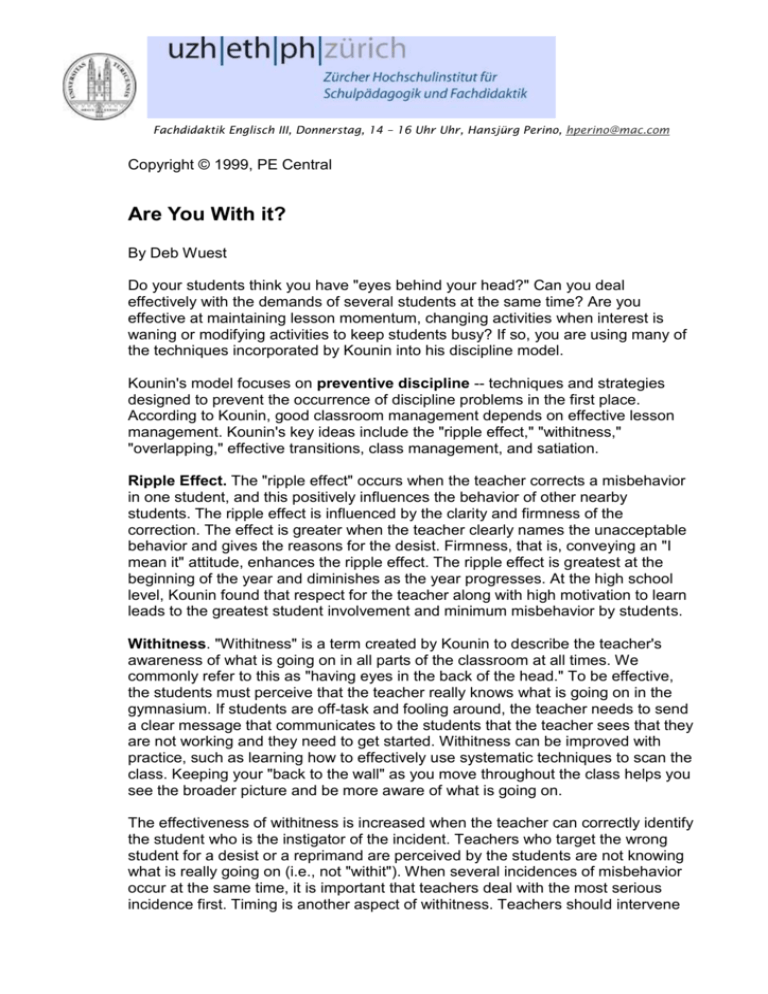
Fachdidaktik Englisch III, Donnerstag, 14 – 16 Uhr Uhr, Hansjürg Perino, hperino@mac.com Copyright © 1999, PE Central Are You With it? By Deb Wuest Do your students think you have "eyes behind your head?" Can you deal effectively with the demands of several students at the same time? Are you effective at maintaining lesson momentum, changing activities when interest is waning or modifying activities to keep students busy? If so, you are using many of the techniques incorporated by Kounin into his discipline model. Kounin's model focuses on preventive discipline -- techniques and strategies designed to prevent the occurrence of discipline problems in the first place. According to Kounin, good classroom management depends on effective lesson management. Kounin's key ideas include the "ripple effect," "withitness," "overlapping," effective transitions, class management, and satiation. Ripple Effect. The "ripple effect" occurs when the teacher corrects a misbehavior in one student, and this positively influences the behavior of other nearby students. The ripple effect is influenced by the clarity and firmness of the correction. The effect is greater when the teacher clearly names the unacceptable behavior and gives the reasons for the desist. Firmness, that is, conveying an "I mean it" attitude, enhances the ripple effect. The ripple effect is greatest at the beginning of the year and diminishes as the year progresses. At the high school level, Kounin found that respect for the teacher along with high motivation to learn leads to the greatest student involvement and minimum misbehavior by students. Withitness. "Withitness" is a term created by Kounin to describe the teacher's awareness of what is going on in all parts of the classroom at all times. We commonly refer to this as "having eyes in the back of the head." To be effective, the students must perceive that the teacher really knows what is going on in the gymnasium. If students are off-task and fooling around, the teacher needs to send a clear message that communicates to the students that the teacher sees that they are not working and they need to get started. Withitness can be improved with practice, such as learning how to effectively use systematic techniques to scan the class. Keeping your "back to the wall" as you move throughout the class helps you see the broader picture and be more aware of what is going on. The effectiveness of withitness is increased when the teacher can correctly identify the student who is the instigator of the incident. Teachers who target the wrong student for a desist or a reprimand are perceived by the students are not knowing what is really going on (i.e., not "withit"). When several incidences of misbehavior occur at the same time, it is important that teachers deal with the most serious incidence first. Timing is another aspect of withitness. Teachers should intervene Fachdidaktik Englisch III, Donnerstag, 14 – 16 Uhr Uhr, Hansjürg Perino, hperino@mac.com early and quickly in dealing with misbehavior. Failure to do so allows the misbehavior to spread. Overlapping. Overlapping is attending to two or more events at the same time. For example, the teacher can give a student individual feedback at one station and, at the same time, offer a quick word of encouragement to students who are working at another station. Or, a teacher can deal effectively with an interruption while keeping an eye on the happenings across the gym. Kounin found that teachers who are skilled at overlapping also were also more aware of what is going on in the classroom or demonstrated withitness. Students are more likely to stay on-task if they know that the teacher is aware of what they are doing and can help them when needed. Transitions. Student behavior is influenced by the smoothness and effectiveness of transitions between tasks in a lesson. Failure to gain the students attention, unclear and confusing directions, using lengthy explanations, dwelling too much on the details rather than focusing on key points, and allowing students to take too much time moving from one task to the next contribute to student misbehavior. Well-established routines, a consistent signal for gaining the class attention, clear directions, preparing students to shift their attention from one task to another, and concise explanations that highlight the main points of the task help reduce student misbehavior. Kounin found that smooth and effective transitions are one of the most important techniques in maintaining student involvement and class control. Group Focus. The ability to keep members of the class or group paying attention to the task is essential in maintaining an efficient classroom and reducing student misbehavior. Effective grouping maximizes active participation and keeps students engaged in learning. Accountability is a powerful force in keeping students ontask. Accountability measures can include record-keeping -- both teacher - and student-maintained (checklists, task cards, etc.), public recognition, skill testing, and written work. When students know that they will be held accountable for their learning and behavior and teachers know how each student is progressing, student misbehavior decreases. Another important technique is alerting -- focusing the attention of the group. Directing students attention to the critical cues in the demonstration, using questions to check for students understanding, and varying the student who is called upon to give an answer are some ways to focus the class attention. Student involvement is increased and misbehavior reduced when teachers hold the attention of the class. Maintaining Interest and Involvement. Satiation, which means being satisfied or having enough, is used by Kounin to describe students progressive loss of interest in the task. When students experience satiation or boredom, other behaviors emerge. Students may introduce variations into the task, work mechanically on the task without giving it much thought, or try to create some excitement through fooling around with a classmate or engaging in other forms of misbehavior. Kounin suggests reducing satiation by providing students with a feeling of progress, offering students challenges throughout the lesson, and being enthusiastic. Variety reduces satiation and alleviates boredom. Changing the level of challenges, Fachdidaktik Englisch III, Donnerstag, 14 – 16 Uhr Uhr, Hansjürg Perino, hperino@mac.com restructuring groups, extending the task, and using different teaching styles add variety to the lesson. Summary. Implementation of Kounin's techniques for class management can reduce the incidence of student misbehavior and contribute to a positive learning environment. Here's a short summary of how you can put Kounin's ideas to work for you. * Be aware of what is happening in all areas of the gym. Scan frequently and systematically; Keep you back to the wall. * Intervene early before the behavior escalates. Correct the appropriate student and deal with the most serious issues first. * Learn to deal with competing demands at the same time. * Gain the students attention. Use routines, concise explanations, and smooth transitions to keep students on-task. * Keep students involved through active supervision and accountability. * Reduce satiation or boredom by using challenges, extending tasks, informing students of progress, and adding variety to lessons. References Allen, T.H. (1999). Developing a discipline plan for you. (http://www.humboldt.edu/~tha1/discip-options.html) Charles, C.M. (1996). Building classroom discipline (5th ed.). New York: Longman. Kounin, J. (1977). Discipline and group management in classrooms. New York: Holt, Rinehart, and Winston.
